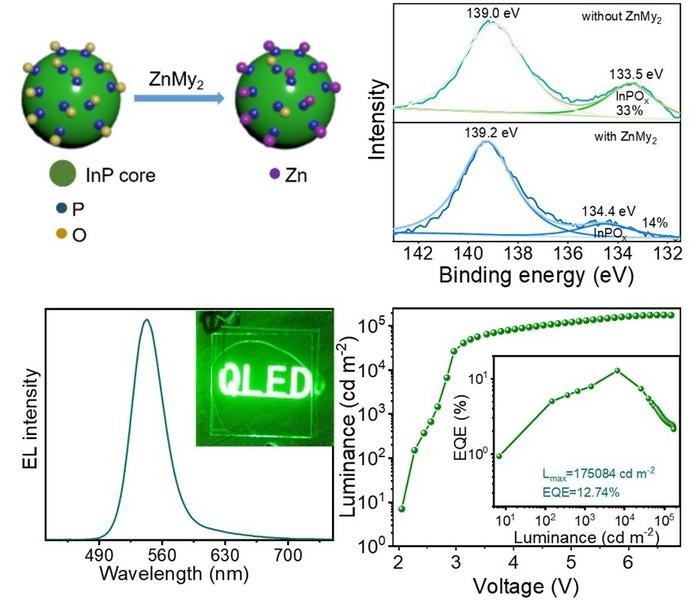InP-based QDs have a wider full width at half-maximum (FWHM) and lower photoluminescence quantum yields (PL QYs) than Cd-based QDs. Specifically, bare InP core has a very low PL QY (<1%) because its highly reactive surface is easily oxidized even in insert reaction chambers.
 In-situ passivation core surface with zinc myristate to improve the optoelectronic properties of green InP-based QDs and its related electroluminescent devices. Image Credit: Professor Fei Chen
In-situ passivation core surface with zinc myristate to improve the optoelectronic properties of green InP-based QDs and its related electroluminescent devices. Image Credit: Professor Fei Chen
According to reports, these materials' low PL QY and non-radiative recombination are most likely caused by flaws from oxidative species. Extensive research has been carried out in the past 10 years to enhance the optoelectronic characteristics of InP-based QDs for lighting and display applications, including adding HF before shell growth or increasing the shell.
Nevertheless, infusing HF at a high temperature causes a sharp increase in pressure and significant corrosivity and toxicity. Therefore, a simple and safe synthesis technique is required to generate high-quality InP-based QDs.
The Solution
Chinese scientists from the Key Laboratory for Special Functional Materials of the Ministry of Education and the National & Local Joint Engineering Research Center for High-efficiency Display and Lighting Technology proposed a fluoride-free synthesis strategy to passivate the InP cores in situ.
In this method, zinc myristate reacted with phosphine dangling bonds to form a Zn-P protective layer, which shields the InP cores from oxygen and water in the environment.
The Result
Green InP-based QLEDs with high brightness and high PL QY are based on InP/ZnSe/ZnS core/shell QDs.
- High PL QY and narrow FWHM of InP/ZnSe/ZnS QDs: FWHM = 44 nm, PL QY = 91%
- QLEDs have an extended operational lifetime of over 20,000 hours, with a T50 @100 cd m-2 lifetime.
- High QLED luminance: 175,084 cd m-2
The Future
Researchers still need to do more to improve the performance of green InP-based devices to commercialize full-color, environmentally friendly QLED technology. Some of these efforts include investigating new InP QD synthesis techniques, delving into the luminescence mechanism of QLEDs, and investigating novel QLED structures.
Professor Fei Chen and Zhenghui Wu said, “With the acceleration of the commercialization of QDs in terms of display and lighting, the performance enhancement of environmentally friendly QDs and corresponding electroluminescent devices has become an urgent task. To realize the commercialization of full-color environmentally friendly QLED technology, the performance of green InP-based devices still requires further effort by researchers.”
Professor Fei Chen and Zhenghui Wu mentioned, “We demonstrated a strategy to in-situ passivate the InP cores, in which zinc myristate reacted with P dangling bonds to form Zn-P protective layer and protect InP cores from the water and oxygen in the environment. This proposed a safe and easy operating route for high-performance green InP-based devices.”
The Impact
These developments offer a fresh perspective on enhancing environmentally friendly InP-based QDs and related QLEDs, which will ultimately hasten the commercialization of full-color, heavy-metal-free, environmentally friendly QLEDs.
Journal Reference:
Cheng, Y., et al. (2024) High-brightness green InP-based QLEDs enabled by in-situ passivating core surface with zinc myristate. Materials Futures. doi.org/10.1088/2752-5724/ad3a83